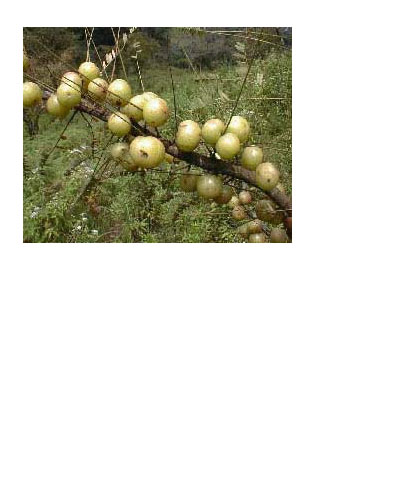Amla
Latin: Emblica officinalis
Therapeutic Action:
The medicinal properties of Emblica officinalis Gaertn. have been mentioned by many authors (Watt, 1892; Kirtikar and Basu, 1935; Burkill, 1935; Chopra et al, 1959; Dastur, 1962; Rao and Siddiqui, 1964; Jain 1968; Khanna and Bansal, 1975). The fruits are diuretic and laxative. They are useful in the disorders associated with the digestive system and are also prescribed in the treatment of jaundice and coughs. Aonla is one of the three ingredients of the famous ayurvedic preparation, triphala, which is given to treat chronic dysentery, bilousness and other disorders. The plant is considered to be an effective antiseptic for cleaning wounds and it is also one of the many plant palliatives for snakebite and scorpion-stinging. The leaves of aonla are used as a mouth wash and as a lotion for sore eyes. An ointment is made from the burnt seeds, and the oil obtained is applied to cure skin infections. A research team discovered that when amla is taken regularly as a dietary supplement, it counteracts the toxic effects of prolonged exposure to environmental heavy metals, such as lead, aluminium, and nickel. These metals are prevalent in the environment of industrialized countries. In the studies the pro-oxidant or oxygen radical scavenger qualities of amla suggest that it is also very effective in lowering the risk of many cancers. Other studies indicate that it is much more effective than Vitamin C alone in reducing chromosomal abnormalities. Amla juice has twenty times more vitamin C than orange juice, and natural tannins prevent oxidation of the vitamin content in a dry condition – in other words, it is heat stable. Studies indicate that the naturally occurring vitamin C is easier for the body to absorb than synthetic vitamin C. This and other studies indicate that naturally occurring vitamin C may be ten times beneficial to the body than synthetic vitamins. The Vitamin C content of amla is between 625 mg – 1814 mg per 100 grams! Other studies show that amla increases red blood cell count and hemoglobin percentages, and patients started their anabolic phase (metabolic processes involved in protein synthesis) sooner. The dried fruit reduced cholesterol levels, indicating that amla is safe to consume on a long term basis. Amla reduces unwanted fat because it increases total protein levels; this is due to its ability to create a positive nitrogen balance and it also significantly reduces the levels of free fatty acids. In addition, amla, in a raw or natural form, reduces cholesterol and cholesterol induced atherosclerosis (Obstruction of the arteries), making it a useful natural product to fight obesity. One study shows that it prevented atheroma (degeneration of the artery walls due to fat and scar tissue). Furthermore, amla has exhibited considerable effect in inhibiting the HIV virus which ultimately results in the disease AIDS. Therefore, one can draw the conclusion that amla is good for almost everyone on a regular basis. It reduces or eliminates the risk of environmental pollutants, normalizes cholesterol, reduces unwanted fat, cures ulcers, reduces or prevents cancer, has the highest content of vitamin C of any natural source, detoxifies the body, regulates digestion, has inhibiting effects against the HIV virus, promotes metabolic function and can produce these results in a dried, natural, unprocessed form. The only thing that could possibly be better than amla for a daily herbal supplement is the Triphala formula, of which amla constitutes one third
References:
- Paranjape, Pages 7-9
- Nadkarni, Pages 480-484
Used in:
- Brain Act Capsules
- Gelunex Capsules
- Ferolon Forte Tablets
- Unexohem Capsules
- Amton Drops
- Sfurti Capsules
- Boroskin Cream
- U-Tex Cream

Copyright 2013 Unexo Laboratories Pvt. Ltd. All Rights Reserved. Designed & Developed By: Credence Technologies


